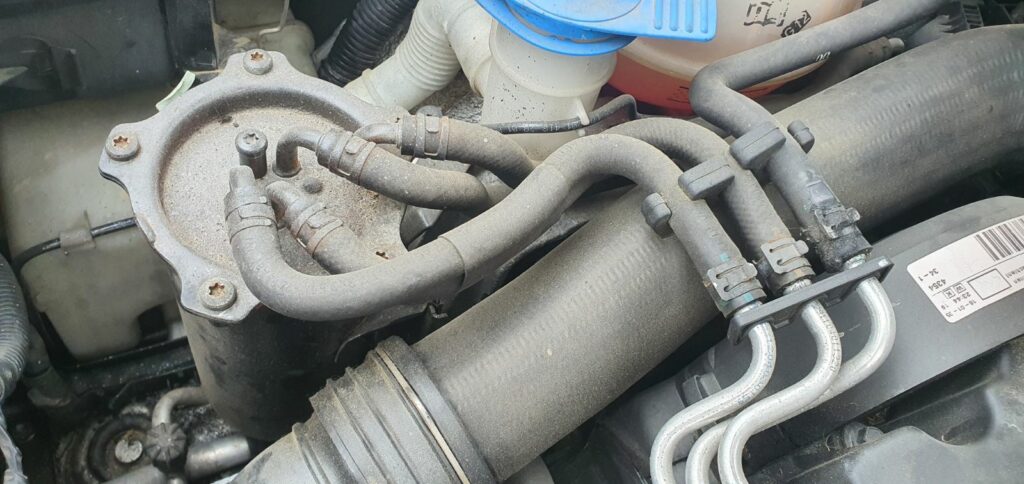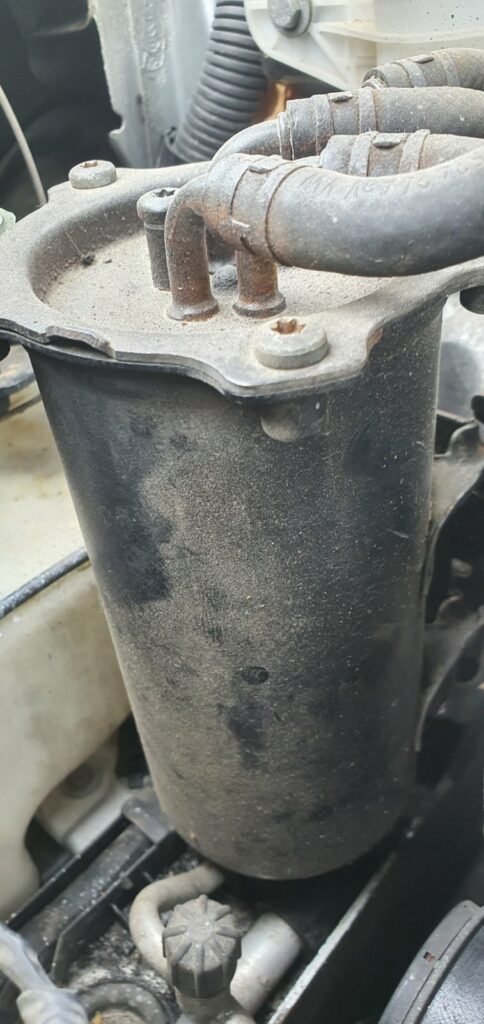If your vehicle has a P0171 trouble code that has been triggered by a clogged fuel filter, you have landed on the right article.
When fuel filters become clogged, they restrict the fuel flow into the fuel injectors.
This leads to a lean condition and a P0171 trouble code is often triggered.
Read on to learn how to remove a clogged fuel filter and fix the P0171 trouble code.
What is The Purpose of a Fuel Filter
The purpose of a fuel filter is to remove any impurities from the fuel before it reaches the engine.
This helps to ensure that the engine runs smoothly and efficiently without being affected by dirt, rust, or other debris that may be present in the fuel tank.
The filter also helps to protect vital engine components from damage caused by particles that can build up over time.
Not all vehicles have fuel filters, but those that do should be inspected regularly and replaced at regular intervals according to manufacturer recommendations.
Without a functioning fuel filter, an engine may run rough or even stop working altogether due to clogged injectors or other blockages within the system.
Can a Dirty Fuel Filter Cause P0171 Trouble Code?
Yes, a dirty fuel filter can cause a P0171 trouble code. A clogged fuel filter restricts the flow of fuel to the engine, which means that there is less fuel entering the combustion chambers than what is needed for optimal performance.
This can lead to an imbalance in the air-fuel ratio and trigger the P0171 trouble code.
To prevent this from happening, it’s important to replace your vehicle’s fuel filter regularly according to the manufacturer’s recommendations.
Additionally, you should always use high-quality gasoline with good detergents to help keep your vehicle’s components clean and free of deposits.
If you suspect that your vehicle has a dirty or clogged fuel filter, have it inspected and replaced as soon as possible.
When Should You Change The Fuel Filter in Your Vehicle
It is recommended that you change the fuel filter in your car approximately every 25,000-50,000 miles or once every 5 years.
Over time, dirt and other particles can accumulate in the fuel filter and reduce engine performance. If the filter gets clogged up, it will prevent fuel from reaching the engine, resulting in reduced power output.
Therefore, it’s important to check your car’s maintenance schedule for when it recommends changing the fuel filter and follow those guidelines.
Additionally, if you notice decreased acceleration or rough idling that could be an indication that your fuel filter needs to be replaced.
The fuel filter is your last defense before the fuel hits your fuel injectors. Any dirt or debris should get caught in the fuel filter so it doesn’t get caught in your expensive fuel injectors.
How To Replace The Fuel Filter To Fix P0171 Trouble Code
Replacing a clogged fuel filter to fix the P0171 trouble code can be a daunting task without the proper knowledge.
Follow each step and by the end of this article, you will know how to replace a clogged fuel filter.
1. Order a new fuel filter
It is possible to clean a fuel filter without removing it, however, I would suggest that you replace it with a new one.
So, head over to your local part store and get a new fuel filter, or order it on amazon.com.
Make sure that the new filter is exactly the same as your old fuel filter.
2. Locate the fuel filter

The fuel filter sits in a metal housing with lots of tubes going to and from it.
If you follow these fuel lines, you will see that they are going into the fuel rails.
This way you know where the fuel filter is.
Or, you can always check your owner’s manual for the exact location of your fuel filter.
3. Disconnect the fuel relay
Before working on the fuel system, always make sure that you remove the fuel pump relay.
In order to do so, open the hood and look for the relay box which is often next to the fuse box.
There are often writings on the plastic cover that suggest the exact location of the fuel pump relay.
Or, you can check your owner’s manual for the proper location.
Remove the fuel pump relay and store it somewhere safe.
4. Relieve the fuel pressure
This step applies to all cars.
With the fuel pump relay removed, try to start your vehicle.
Let the vehicle crank for three to five seconds and do not worry because the vehicle will not start.
By doing so, you have successfully relieved the buildup pressure in the fuel filter.
5. Disconnect the old fuel filter

The fuel filter housing is held in place by three screws on top and multiple fuel lines.
First, disconnect the fuel lines using pliers and then remove the bolts that hold the top in place.
Always have a towel or a can near because there is fuel in those lines as well as in the fuel filter.
Once the housing is open, remove the old fuel filter using pliers.
Make sure to grab any large pieces if present in the fuel filter housing.
6. Install the new fuel filter
Place the new fuel filter in the housing as shown on the instructions (which way down) and place the top lid on.
Reinstall the crews that are holding the fuel filter housing in place.
Now, reconnect all of the fuel lines back in place.
Make sure everything is tight and no fuel is leaking.
7. Reinstall the fuel pump relay
Reinstall the fuel pump relay and make sure that it is secured in place.
Do not close the hood just yet.
8. Start your vehicle
Turn the key into the On position and turn it off. Do this about five times.
What this does is forces the fuel pump to release fuel into the new fuel filter.
Try to start your vehicle.
If it doesn’t start right away, do not worry. Some vehicles take time with a new fuel filter installed.
Once the vehicle starts, check for any leaking around the fuel filter.
9. Erase the stored P0171 code
Connect an OBD2 scanner and erase the stored P0171 trouble code.
If you are not sure how to do it, check out this article: How To Reset The P0171 Trouble Code After Repair In Under 5 Minutes
At this point, you have replaced the fuel filter and fixed the P0171 trouble code.
In Conclusion
Replacing a clogged fuel filter will not only fix the P0171 trouble code, but it will improve the overall engine performance.
When the fuel filter is clogged, the fuel flow is restricted.
This can lead to all sorts of problems. So make sure that you always replace the fuel filter on time.
